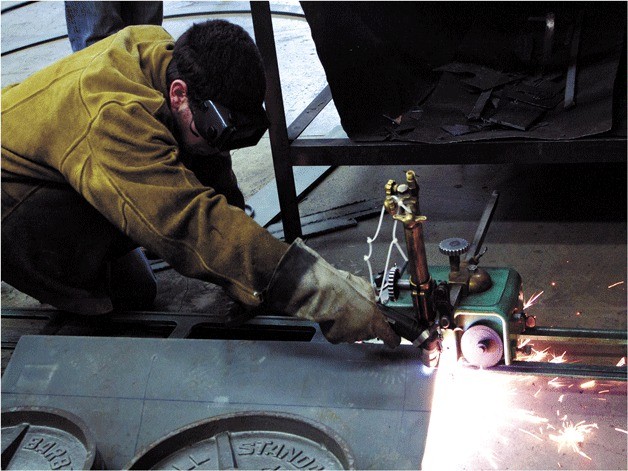LANGLEY — There are plenty of practical projects at South Whidbey High School’s metalwork and woodwork classes.
There are some impractical ones, too.
Regardless of the utility, the half-finished engines, the assembled sheds and the Popsicle stick bridges are all part of Chad Felgar’s woodworking and engineering classes.
Perhaps the most illuminating project the 22 Advanced Metal Fabrication students have worked on is the Admiralty Head Lighthouse. The elite group was hand picked by Felgar when the project began in February.
“They could go work on the trucks, but when it was time for their job, they’d get on it,” Felgar said. “It worked really well.”
He had a welding contest in the class to determine his best welders. Each student had a task, including welders, grinders, supervisors and even public relations.
“We found their best skills and what they would offer to the project,” Felgar said. “We ran it like a job site; like a business.”
The restoration project was divided between Whidbey Island’s three high schools. Coupeville High School had the roof, a conical shape. Oak Harbor was in charge of the curved windows and circular viewing area. Both rested on top of the 1-inch thick steel tub — a circular formation 8 feet in diameter that supports the windows and roof — that South Whidbey finished welding together recently.
The work that his students put into the lighthouse left the teacher beaming with pride.
“The kids are doing it. We pride ourselves that I haven’t done anything on it, the kids have,” he said.
A project timeline was established and a calendar was tacked on the wall with the assignments and deadlines. Every day the students fill out work reports and grade themselves on a 1 to 5 scale of how much they worked. A 1 means not at all, a 5 means highly productive. Then Felgar reviews the reports at the end of the week.
He said a week full of 1’s or 5’s would be suspicious. Though, he’s never seen it because the students appropriately use the freedom their given in his class.
One of the student welders was confident in the abilities he received from the shop classes — after all, he’s been in five.
“You can take this to college and you can apply it,” said junior Zack Caravan. “Not a lot of people can do it and it pays big bucks.”
All that remains for South Whidbey’s portion is some grinding on the welds, installation of a small door for the tub and paint. Then, final assembly of all three pieces will take place at one of the schools before being delivered to the lighthouse at Fort Casey.
“The lighthouse has been there 100 years, so this is going to be there another 100 and we want it to look nice,” Felgar said.
The courses are like the relics and beaters that auto shop students repair — both needed work.
Some schools have cut auto mechanics or woodworking classes altogether. Other districts, like Everett and Mukilteo, created separate vocational and technology schools to teach students about engineering, auto mechanics, welding, drafting and woodworking.
South Whidbey has kept its auto shop and woodworking classes as part of its push for course integration called Science, Technology, Engineering and Mathematics.
South Whidbey’s shops are far from the public eye, however. They are tucked at the back of the school near the baseball field. Junker cars litter the lot, sprinkled with some students’ cars.
They can bring in their cars to change oil, rotate tires and replace clutches, like senior Will Zink did during a recent session of fourth period Advanced Metal Fabrication. Any certified work, such as brake replacement, won’t be done at the high school for safety and insurance reasons.
Then there are the more showy experiments. Junior Aaron Curfman and a crew of three students worked on a rig for next year’s Soup Box Derby. It’s a two-wheeler that resembles a low-riding motorcycle complete with high-tail exhaust pipes purely for decoration, though Curfman said he may add dry ice to give the effect of exhaust.
In one of the shop’s closets sits the next minor project. Felgar and the fourth-period advanced shop students want to make a miniature monster truck for the homecoming football game Oct. 14. The three-foot-high Falcon-blue truck will roll onto Waterman Field on tires larger than the frame.



